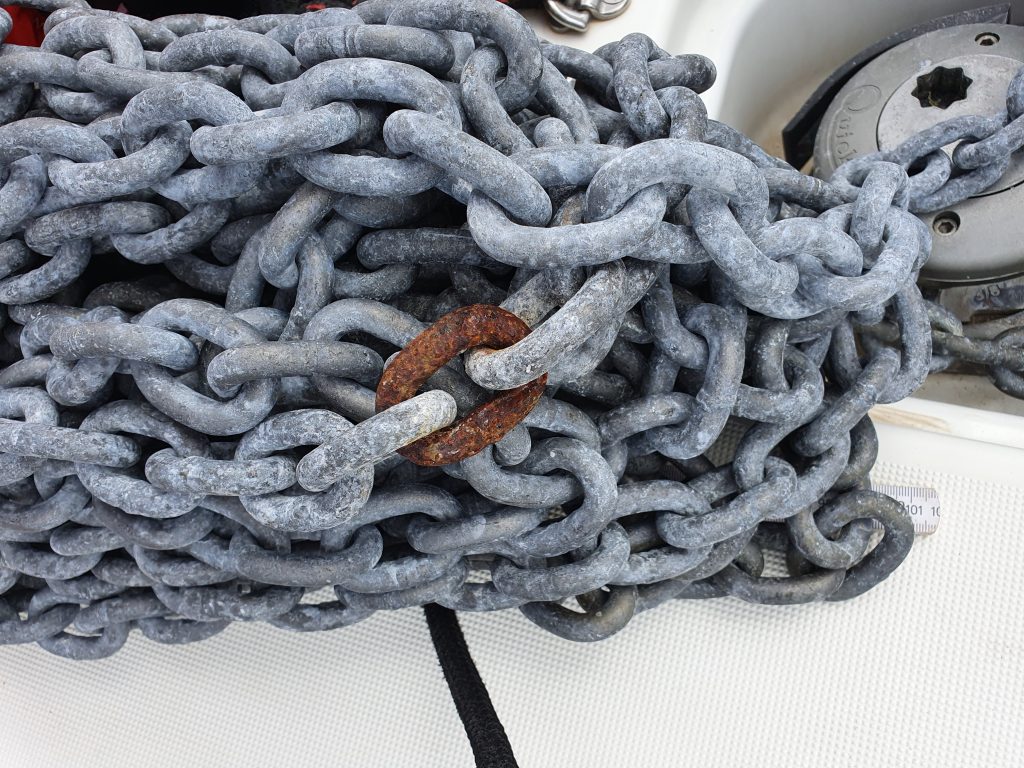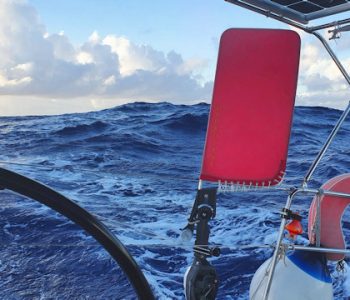 Allgemein
Allgemein
Vessel Maintenance
After some lazy days and a home leave it is time to prepare Aurelia for the next journey. For vessel maintenance we will sail to the shipyard in Willemstad.
Checking the Rig
Right next Monday after coming back Gijs came to the marina. Since the boat has to be in the water while checking the rig, it was better to do it here without any disturbances from other trades.
He found no issues. No wonder because the 6 year old Aurelia is still quite young. But on the other hand – we had enough issues on the Atlantic I did not expected. Now I can put my worries aside, at least for the rig.

Anchor Chain
At the beginning of our Journey in Locmiquelic we stored the 32 meter of second chain below the new main chain. This measure didn’t worked well. By moving it back to the aft locker I lost some storage capacity but I gained a higher bow by at least 5 cm. This should decrease the weather helm, I had some trouble with last months. It could also increase the speed a bit as the bow doesn’t dive that deep into the waves.
In the middle of the new 60 meter chain I found a rusty link without zinc. That’s annoying. Meanwhile the SVB sent me fluid zinc and a stainless wire brush on top. This shop surprises me again with kindness, competence and speed. Other shops might learn a thing or two from this. So the problem can be fixed soon.

To the shipyard
On the morning of March 16th I made my way to Curacao Marine. It was the first time that I was alone on the ship. But only for a few minutes. First I went to the gas station in Spanish Water. There I met a companion. We got to know each other on Instagram and were considering sailing to Colombia or Panama together.
We just putted fuel nozzle back to the gas pump the first rain shower arrived. Whatever, this is not new to me.
The two of us covered the five nautical miles to Willemstad. The pontoon bridge opened without any problems after we got wet again. A cargo ship came towards us on the way to the bay. A small tugboat hurried over to ensure a save situation. They helped the cargo ship follow the curve of the canal.
The mooring went smoothly with the support of my temporary crew member. Before we were allowed to go ashore, we first had to answer a few questions so that they could assess our risk of infection. After successfully surviving that, we enjoyed the relief of an “Oranjeboom”.



In the evening I got to know my neighbors. An Israeli couple on a brand new Bavaria and a Canadian family on a catamaran. The latter had little time. Tomorrow they are going to get out of the water and head straight for the airport back home. It should be the last possible flight for the time being.
From wet to dry berth
On the afternoon of March 17th it was Aurelia’s turn. I steered her to the slipway. The sonar was constantly reporting its discomfort at the lack of depth. I approached the cleats on the side very carefully. After a short wait, the tractor was ready. Take a look at the decisive moment for yourself. Here it is at 10 times speed:
Silic One
The Aurelia was cleaned with high pressure directly behind the slipway. The shipyard employee was informed about the silicone coating and was accordingly careful. At the same time, he seemed quite amazed at how easy it was to clean the hull.
When I got to the dry berth , others looked confused at my underwater hull and asked why I had taken the boat out of the water. One of them remained at the boat for 20 minutes and kept repeating “unbelievable”. I think Hempel made some new friends today with his Silic One.
A few small spots need to be repaired. The French shipyard in Locmiquelic had slumbered a bit in the channel of the bow thruster in particular. Unfortunately not the first time. Actually, I wanted to forget all the frustration about the shipyard there, but the following rudder topic brought it back – at least from my point of view.




Defect Rudder
The chief mechanic of the shipyard joined my inspection of the underwater hull. I had such a premonition and asked him to check the bearing clearance of the rudder. His assessment: “It can’t stay that way. The clearance is way too big. It didn’t just come about last year.”
But I am sure that when I bought this yacht I checked the rudder bearing clearance. There was none. Now I remember finding a piece of silicone at the rudder just before crossing the Atlantic. The only sense I can think of is for someone to obscure the rudder bearing clearance with some silicone. You can’t call it a repair. If so, it’s outrageous!
However, it needs to be fixed. After removing the rudder, it became clear that the copper bearing shell had been detached from the fiberglass. The rudder moved between fiberglass and copper instead of copper and stainless iron. Logically this had worn out some fiber. The mechanics measured the wear with tinplate from a Coke 😮 and glued the bearing shell into the hull with some epoxy. Lots of grease in the bearing should prevent it from getting stuck.




Lockdown fear
The next day some of my friends came to see me. Before they took me to the supermarket, we practiced the new greeting rituals.

The measures against Covid-19 become stronger hour by hour. Only one person was allowed to enter the office of the yard. Organized come together were canceled. The marine traffic between the islands was largely stopped. First rumors about a curfew made the rounds. My Dutch neighbor followed the latest press conference and translated the most important things for me: a lockdown has not yet been announced, but hinted at.
Night Shift
On March 19th a lot of work was done. The mechanics completed the rudder repair and performed the maintenance of the engine. Another employee helped me sand the bow thruster channel and the rudder of the wind vane while I swapped the anodes. That wouldn’t actually have been necessary yet. They had barely lost mass and could easily have held for a second, probably a third year. Why do the others have to change annually? Is it because of the shore power? Possibly. Thanks to my solar system, I was rarely connected to the grid.



The last thing I had to do was touch up the defective areas of the silicone paint. Depending on the size and depth of the damage, 1 to 4 coats were necessary at the specified intervals.
Due to the impending lockdown, I was in a hurry and wanted to get back to my marina before the weekend. Firstly I feel safer there in the event of a lockdown, secondly the temperatures in the saloon on dry berth are 40° C, around 10° higher than in the water. So that means: night shift. I set the alarm clock at the shortest possible interval. At 5:00 am the last coat of paint was applied. Enough time to dry before the vessel goes back into water.






Back to the marina
Arround Midday of March 20th all formalities are done and the bill was payed. After a last chat with my neighbor, I marveled at his concrete boat again. Yes, you read that right. Concrete boat are actually exist. So far I thought they only existed in the form of floating platforms or a few freighters from the last century. Obviously I was wrong. Right next to me there was a sailing yacht you can touch. The owner had sanded it down with a lot of effort, sweat and support in the last few days. So you could see the material well.

Shortly before employees lunch break, the Aurelia went back into the water after only 69 hours on land. Of course not without the associated rain shower.

The trimaran with the massive sails came into the water immediately before of me (shown in the picture above on the left). I would have liked to take a closer look at it, but I was too busy. Unfortunately, the opportunity will never come again. The interesting boat capsized off Curaçao a little later. Weeks later it was found off the coast of Columbia. Here is a short video. Small hint: watch it w/o sound.

Right after the boat was swimming I went back to Seru Boca Marina. This time the pontoon bridge opened only after a radio call. I used the opportunity to inform the coast guard about my trip back to the marina and got a green light.
Marine traffic had already largely come to a standstill due to the corona crisis. The restaurants on the quay were also closed. The city appeared to be deserted. Spooky!

Around 3 pm I had my first single handed but still smooth mooring at the Seru Boca Marina. I was happy that everything went so well this week. Technically nothing stands in the way of the second stage.










